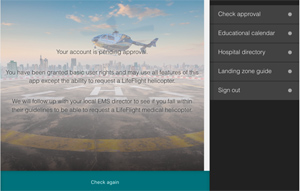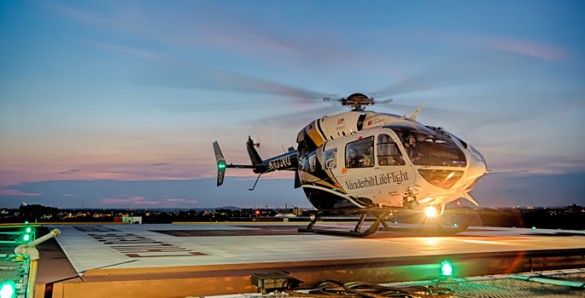Vanderbilt LifeFlight has developed a new app that allows for emergency responders to request a helicopter at the tap of a button. The app also uses computer-aided software to send the emergency responders’ location and other helpful information directly to dispatch personnel at LifeFlight’s Communications Center.
The app, developed in partnership with LifeFlight’s computer-aided dispatch vendor Flight Vector, has a multitude of features helpful to emergency personnel. Not only can users request a helicopter via the app, they can also receive push notifications from LifeFlight on education and upcoming training events, access to LifeFlight’s training event calendar, a hospital directory and a landing zone guide.
“We have worked for more than a year to develop this app, and its rich interoperability with our dispatching and flight tracking software,” said Stephan Russ, M.D., associate professor of Emergency Medicine and associate chief of staff at Vanderbilt University Adult Hospital (VUAH).
Russ said discussions for an app had been underway for several years but always concluded with no efficient and reliable way for the Communications Center to receive requests.
“We considered a variety of ways to receive calls, including text messaging,” he explained. “But none of those ways provided an efficient and reliable way to actively receive emergency flight requests.”
That dynamic changed when the company performing the computer-aided design agreed to marry the app with its flight-dispatching software – so that the request became an integrated part of the dispatch process.
“It’s seamless and a time saver,” Russ said.
Simply tapping the “flight call” button on the app sends users’ information to Vanderbilt LifeFlight that includes their GPS coordinates, name, organization, and other information the user is able to type into a text box.
This information pops up as a new “mission strip” on a computer screen at the LifeFlight Communications Center, where personnel are monitoring the computer-aided dispatch software (Flight Vector). A visual and voice alert that a new flight request has been received by a mobile app user” is also triggered.
Once the aircraft has been launched, the emergency responder who made the request will receive a notification on the app that shows which aircraft has been dispatched, and a map will display with the estimated flight time and estimated time of arrival. A red line will appear on the map with the projected flight path.
“We’ve been fortunate to be able to partner with Vanderbilt LifeFlight on this exciting project,” said Scot Cromer, president & CEO of Softtech Inc., the software developer of Flight Vector.
Cromer said that his company has been so impressed with the Vanderbilt LifeFlight app and its ability to interface with Flight Vector that it will release a similar version to other Flight Vector customers across the country. Each version can be configured to be specific to the area for each customer’s flight program.
“Working with a national leader in the air ambulance industry like Vanderbilt LifeFlight has given us great insight into how an end emergency response user will use the app for a variety of functions,” he said. “Once we began development and testing we approached Vanderbilt LifeFlight about our ability to offer this app to other Flight Vector air ambulance programs. They agreed it was a great tool for emergency responders. So, we will be offering a very similar product to our customers across the country.”
The app is available on the Apple App Store and on Google Play.
Since 1984 Vanderbilt LifeFlight has flown more than 41,000 patients and is accredited by the Commission on Accreditation of Medical Trauma Systems (CAMTS). LifeFlight transports to any medically appropriate hospital and has immediate access to the region’s only Level I Trauma Center, Burn Center and Children’s Hospital, all at Vanderbilt.
Air Methods Corporation provides aviation, fuel, maintenance, aircraft, dispatch, billing and EMS licensure while Vanderbilt University Medical Center provides all medical staffing, patient care and clinical services for Vanderbilt LifeFlight.















